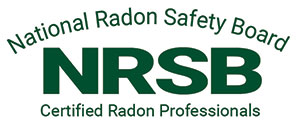Alpha-Track Testing – Explained
In the radon industry there are only a handful of ways to test for radon. Passive and active style devices include, electret ion chambers, liquid scintillation, activated charcoal, continuous monitors, and alpha track detectors. Even though they make up a vast number of the tests performed, there is still a lot of mystery surrounding alpha-track detectors. “What are they?”, “How do they work?”, and “Are there benefits to testing with them?”, will all be discussed to help provide a better understanding of these devices.
What are alpha-track detectors?
Alpha track detectors are a relatively simple looking device. Small and lightweight.
Laboratories like Radonova, RSSI, and Accustar Labs, all manufacture an alpha track detector. While the designs will vary the premise is the same. Generally, they are a plastic housing that has a point of entry for air to enter the ‘chamber’ of the device. Each device contains an enclosed piece of CR-39 material. This material is also plastic, like that of lenses in glasses, that when treated will absorb the impact of the released alpha particles.
How do alpha-track detectors work?
We understand radon tests primary work when they are interacting with radon gas as it goes through one of its stages of decay. During this decay process, radon fires off alpha particles. These particles are traveling so rapidly that when the particles collide with a material, they can leave a ‘track’.
When the test is completed, labs will count the tracks in an exposed chip. Special algorithms can calculate the amount of radon needed to produce the number of tracks on a chip. This is how the total concentration is determined. Once that is determined, the average is calculated based on the amount of days the test was deployed. Commonly, alpha-track tests are deployed for a minimum of 90 days up to one full year. However, there are some tests, like the Rapidos® device manufactured by Radonova that can be deployed for as little as 10 days.
Benefits
With the EPA and WHO both aligning their guidelines with conducting a year long test, the major advantage to alpha-track tests is their ability to be deployed this long.
Being that alpha-track tests are being deployed for such a long time; they also do not require closed home conditions. Often referred to as a ‘living conditions’ test, these devices want your radon level to fluctuate how it would normally while you were living in an area.
One of the best reasons to use an alpha-track test is for the average. Shorter term tests tend to favor latter parts of monitoring periods and can be heavily influenced by rapid spikes or declines in a radon level. By taking into account all of the spikes, declines, and data, a true statistical average is reported at the end of the monitoring period.
Daniel Roak
Guest Contributor

